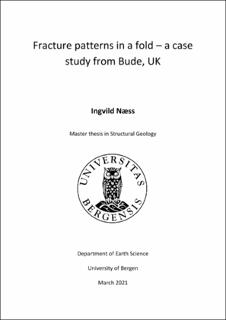| dc.description.abstract | Fracture patterns in a well-exposed folded Carboniferous sandstone and shale sequence at Bude, SW England, have been analysed, and the use of such surface analogues for modelling fracture systems is discussed. Each fracture is identified as a vein or a joint, or as a “fracture”, if it is unclear whether it is a vein or a joint. These fracture types are a basis for defining sets, along with orientations and relative ages. Seven fractures sets have been identified individually at each limb and at the crest of the Whaleback fold, using field observations and analysis of drone images. Fractures sets at one location on the fold can correspond with the fracture sets at another location. Some fracture sets at the crest could not be correlated with sets on the limbs, so a total of ten fracture sets are identified on the fold. The fracture networks and the quality of the exposure vary across the fold. The northern limb shows a wide range of fracture orientations and a clear distinction between veins and joints. The southern limb shows a more limited range of orientations and it is more difficult to distinguish between veins and joints. The crest is the most weathered and shows fractures that are difficult to map because of erosional features. The relative ages of the fractures are determined mainly based on fracture type and their abutting and crossing relationships. Pre-folding veins are identified based on orientations when unfolded. Syn-folding fractures are identified by their positions in the fold and includes two set of veins, joints that strike parallel to the fold hinge line and intense vein networks in an underlying sandstone bed. Some joints can be traced across the fold as relatively straight and vertical joints and are therefore interpreted to post-date folding. The Whaleback fold does not show four sets of joints, including “shear joints”, which are commonly shown in models for joints in folds. This is probably because such models imply that joints formed synchronously with folding, while most joints on the Whaleback fold are interpreted to post-date folding. Similarly, there is no evidence that show an increase in joint formation as the strain or curvature increases. This suggests that models that use strain or curvature to predict the distributions of open fractures in the subsurface can give incorrect results. | |
